Featured Golf News
Golf in Ireland - The Final Leg
The fourth and final part of this Irish golf adventure finds us at two similar, yet contrasting, golf courses: Doonbeg Golf Club, a Greg Norman design hatched in 2002, and Lahinch, a classic 1892 links that sprawls across sand hills near its namesake town and boasts a fond place in the hearts of golfers around the world.
Before dipping our toes into these shallow and deep waters of those two courses, let's talk about the confounding perspectives of golf in Ireland and the United States.
An Attractive Game at Heart
It's interesting that roughly half of the rounds on Ireland's fabled links are played by Americans, who flock here at great expense. What's odd is that the conditions of these courses are far from the pristine, manicured layouts many of these same peripatetic Americans expect at home. Consider this: U.S. superintendents are pulling their hair out as members request using a Stimpmeter to measure the speed of FAIRWAYS. This is no joke.
Over in Ireland, the opposite is the case. Though many of the nation's seminal links have been retrofitted with modern irrigation systems, nature provides the primary nourishment of the fairways, tees and greens. Putting surfaces are mowed maybe twice a week in Ireland, versus four to five times over the same period in the U.S. Pesticides, fertilizers and herbicides are much less frequently used in Ireland, where the fairways are not the low-cut, pure-grass wonders found in the U.S. Dandelions and other weeds are whacked off - rather than chemically eradicated. But this happens only when the big mowers are fired up once a week or so. 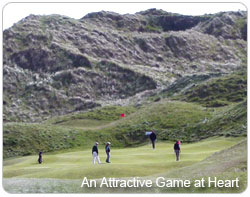 So why do Americans flock to these rugged, windswept links? Because of their beauty and history, of course. Perhaps a more important question is: Why do Americans insist that their home courses be so immaculately tended when they obviously have just as good a time - and face just as stiff a challenge - when playing Ireland's rough-hewn courses?
So why do Americans flock to these rugged, windswept links? Because of their beauty and history, of course. Perhaps a more important question is: Why do Americans insist that their home courses be so immaculately tended when they obviously have just as good a time - and face just as stiff a challenge - when playing Ireland's rough-hewn courses?
Also, why do many American golfers insist that the folks who take care of our courses budget several hundred thousand extra dollars a year - which, of course, must be offset by higher green fees and/or membership dues - to make them so "perfect"?
The Golf Course Superintendents Association of America and the heads of the USGA's Greens Sections have repeatedly beseeched U.S. golfers to lower their expectations and allow superintendents to raise the height of their greens to a safe level. Myriad reasons are cited.
Principally, lower green heights propagate disease and spawn a higher risk of permanent damage (even death) of the turf. Keeping the things alive by watering - which can easily result in over-watering without the assistance of a computer - in an attempt to create a verisimilitude of that PGA Tour track we see every week on TV, also propagates pathogens. Don't mention the depletion of an increasingly dwindling natural resource.
Golf in recent years has become an easy target for folks who don't have better things to do. These people have simple emotional needs which can't be satisfied by family and friends. Under the banner of "environmental protection," they need a mission. And golf courses, those expansive greenbelts where the landed gentry romp and frolic, are in their bulls-eye. Acres of verdant, clipped and lush grass, fed by millions of gallons of precious water; tons upon tons of "vile" chemicals to revivify the landscape. Bambi's in danger of extinction is the hue and cry.
So how do we respond?
In an attempt to waylay environmental fears and the U.S. Army Corps of Engineers (the agency that, in conjunction with local governments, regulates wetlands and other environmentally-sensitive areas), the Audubon Sanctuary Program was developed. Golf courses that have an "Audubon" tag attached to them treat the designation as a marketing opportunity, while implying their owners are benevolent ecological shepherds, which, in many cases, they are.
Yet American golfers still have a much higher standard for conditioning for their HOME courses than elsewhere in the world. Thousands of well-educated and hard-working American superintendents at many non-Audubon golf courses minimize their chemical usage, ensuring that local wildlife habitat thrives and everyone is happy. After all, golf courses ARE good for the environment.
This is clearly proven at the wonderful links of Ireland and Scotland: naturally occurring stretches of grasslands inhabited by all manner of critter and fowl. For centuries.
Now, if only American golfers would realize that perfect conditions aren't necessary . . . their standards could be really raised.
Our Guides
Jim B
As noted in Part 1 of this travelogue, our Seattle group was escorted through our 10-day trip by the folks from Irish Golf Experience. Jim Bocinsky is the founder and managing partner of the four-year old company, whose focus is customized golf tours of the Emerald Isle. Bocinsky lived in Ireland in 1999 and 2000 after a successful career in high-tech sales in the Pacific Northwest. Jim came to Ireland when his wife, Maren, was assigned to the Microsoft European Operations Center in Dublin for two years. The couple is back in the Seattle area, where they reside in Sammamish, Wash. Jim is a member at the Members Club at Aldarra, a Tom Fazio design on the Boeing family's old farm.
Kevin
Jim's partner is Kevin McGrath, a Dublin native. Kevin is a natural fit. He's a fine golfer and member of both Portmarnock and Lahinch. While attending University College Dublin in 1972, Kevin captained the team that won the Irish Universities Championships for the third year in a row. Kevin also led the Irish Universities Team that beat the Scottish Universities for the very first time in Scotland. He played many times in the Irish Amateur Close Championship, and also competed in the Spanish and French Open Amateur Championships.
After finding success with several engineering and distribution companies, Kevin moved to Lahinch, where he now lives in a waterfront home with Geraldine Reidy. Their place is called Long Cove Lodge (http://www.longcovelodge.com/), a comfy B&B with great views across the bay toward the nearby golf links. As a mechanical engineer, Kevin traveled extensively in the U.S. Among the impressive arrows in his golf course quiver are Augusta National, Baltrusol, Chicago GC, Congressional, the Country Club of Brookline, Cypress Point, Maidstone, Medinah, Merion, National Golf Links, Olympic, Pebble Beach, Pine Valley, Riviera, San Francisco GC, Seminole, Shinnecock Hills and Winged Foot. As a result of his American travels, Kevin is the only Golfweek course rater who lives in Ireland.
Brendan
Brendan Martin was our driver. Spring, summer and fall are the busiest times for the motormen on Irish golf tours. As noted by the accompanying photo of Brendan and his three young daughters, misgivings arise whenever he heads out on a week-long trip with Buckley's Tours (http://www.buckleystours.com/) and a visiting group of golfers. But as they say in Iowa, you've gotta cut the hay when it's high. Brendan enjoys his prolonged time off in the winter. 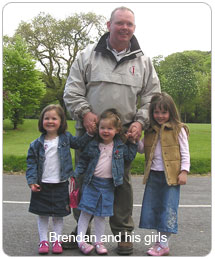 After a successful career as an Irish football player, Brendan became a fireman in London. He saved people from burning buildings, rescued cats from trees, set up passersby outside the station house with some hilarious gags, and did all the other tasks of someone in that worthy profession. Unfortunately, after 12 years on the job he developed asthma from the smoke, and was forced off active duty to take a desk job, which he disliked intensely. So, after an early retirement and a valiant attempt as a teaching pro and junior golf instructor in his now-hometown in Kanturk, County Cork, Brendan took to the road.
After a successful career as an Irish football player, Brendan became a fireman in London. He saved people from burning buildings, rescued cats from trees, set up passersby outside the station house with some hilarious gags, and did all the other tasks of someone in that worthy profession. Unfortunately, after 12 years on the job he developed asthma from the smoke, and was forced off active duty to take a desk job, which he disliked intensely. So, after an early retirement and a valiant attempt as a teaching pro and junior golf instructor in his now-hometown in Kanturk, County Cork, Brendan took to the road.
If you're planning an Irish golf tour and need a guide with a keen eye, ask about Brendan Martin. He's extremely knowledgeable about the country and a very good stick to boot; the 5-handicapper played six of the seven rounds with us and was a blast to play with. He was especially helpful in giving me valuable guidance for handling knock-down shots - a requisite weapon in any golfer's arsenal in Ireland.
Aidan
Though he was not a member of our group, special thanks must also go to Aidan Bradley, an Irish-born photographer who contributed several pictures in these four installments (including five of Doonbeg and Lahinch in this article). Now a resident of Santa Barbara, Calif., Bradley has become a preeminent photographer of golf courses, with a special emphasis on those in his native country. For additional information and a glimpse at Aidan's wonderful work, visit http://golfcoursephotography.com/home.asp.
Doonbeg Golf Club
Though it sports a name that would fit any of Ireland's century-year-old links, Doonbeg is a mere babe in the woods of this country's hallowed courses. The County Clare venue (http://www.doonbeggolfclub.com/) is part of a 385-acre development comprised of four former farms. Portions of the property are where Ireland's Black Watch Regiment trained. According to a chap in Doonbeg's sales office, the land "has been sitting here 100 years waiting for a golf course." 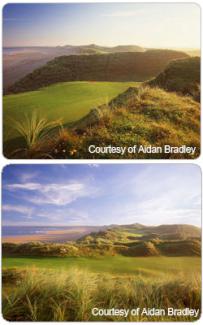 Like many other golf facilities in Ireland, Doonbeg is a pseudo-private club with 400 or so members, including many Americans. The high-end facility, projected to cost between $100 million and $150 million at full build-out, is owned by Kiowa Development Partnership, a Charleston, S.C.-based company that operates two private clubs in its home state, Kiowa Island and Cassique.
Like many other golf facilities in Ireland, Doonbeg is a pseudo-private club with 400 or so members, including many Americans. The high-end facility, projected to cost between $100 million and $150 million at full build-out, is owned by Kiowa Development Partnership, a Charleston, S.C.-based company that operates two private clubs in its home state, Kiowa Island and Cassique.
While we were at Doonbeg, dozens of workers were hammering and sawing and pouring concrete for a huge new lodge. Overlooking Doughmore Bay and the Atlantic Ocean, the structure - the largest for miles around - will contain a formal dining room, member areas, a spa, clubhouse and 44 overnight units when completed in October 2005. Doonbeg - with green fees ranging from 180 to 195 Euros (over $200) and $40,000 memberships - is definitely seeking a high-end clientele. Examples of this are the headphone-wearing "golfer assistants" who unload your clubs, escort you to the pro shop, and drive you over to the driving range.
Doonbeg's course has a quirky configuration, owing chiefly to the removal of a critical 54-acre interior parcel where two endangered species of snails were discovered during construction. As a result, the layout is almost a loop-style - nine holes out and nine back. But not really. The holes follow a spidery pattern encircling the edges of a major body of saltwater. There is no doubt Doonbeg is a links, with greens in hollows, steep-edged pot bunkers and rolling greens mirroring the waves on nearby Doughmore Bay.
The configuration of holes is noteworthy; there's only one par-3 on the front side, yet three on the back. From the tips, the initial nine stretches a manly 3,639 yards (par 37), while the back is a much shorter 3,195 (par 35) yards. The best tests are No. 1, a beautiful opener that follows a winding, rolling path. The 18th is a dandy 437-yard par-4 that curls rightward around the bay to a deep but skinny green. Off to its left is the massive new lodge.
Caveats
Some of Doonbeg's design elements are not to my liking, such as the hidden bunker in the middle of the 12th green. After busting a great drive into the middle of the fairway on this 365-yard par-4, I was left with an 80-yard shot in. Lookin' good. Not. Even though I was warned of the bunker in the middle of this putting surface, I still couldn't see where it was, despite the close vantage. I had to walk up and take a peek, retarding the progress of our foursome. Thus forewarned, I took a sand wedge and shot to the right side (the pin was behind the trap this day) and missed right, leading to a double-bogey.
I'm sorry - this kind of bunker-in-the-green hole is too contrived. It's not a novelty, nor the makings of a "signature" hole. Double-bogey or not, this kind of forced design is a slow-play creator and inappropriate for a fine golfing nation like Ireland.
Another problem are the cavernous bunkers on the par-5s, some of which were lying 350 yards from the greens. I don't mind sand, but deeply dislike the tall, ball-grabbing grass surrounding many of these deep fairway and green-side bunkers. Several of us hit shots toward these traps, which is expected. But when we tried to find our shots, our balls were not in the sand, but hidden (and even lost) in this thick grass.
I suspect - and hope - Doonbeg will do further renovations. It most definitely doesn't warrant a place in the pantheon of Ireland's best courses as yet, despite its moneyed backing and illustrious architect. The only factor that makes a classic links course is soul. Doonbeg has the site. It has the potential. But it's not there yet.
Lahinch Golf Club
No such sentiments with this course. It's been here a long time and everyone knows it. 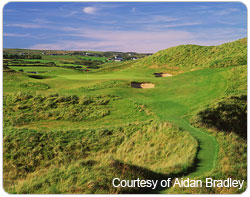 This historic course is on par with Waterville, Ballybunion, Royal Portrush and Royal County Down as among Ireland's greatest links. Originated in 1892, Lahinch (http://www.lahinchgolf.com/) was designed by Old Tom Morris, though club history states that E. D. Hunt, from Limerick, A.W. Shaw and R.J. Plummer were helped in the original layout of the course by some officers of the Black Watch Regiment stationed in Limerick. Because of its connection to Old Tom, Lahinch is often called the "St. Andrews of Ireland."
This historic course is on par with Waterville, Ballybunion, Royal Portrush and Royal County Down as among Ireland's greatest links. Originated in 1892, Lahinch (http://www.lahinchgolf.com/) was designed by Old Tom Morris, though club history states that E. D. Hunt, from Limerick, A.W. Shaw and R.J. Plummer were helped in the original layout of the course by some officers of the Black Watch Regiment stationed in Limerick. Because of its connection to Old Tom, Lahinch is often called the "St. Andrews of Ireland."
The first Haskell (rubberized) ball struck in Ireland purportedly took place at Lahinch. A member teed up the then brand-new ball and his drive sailed merrily down the middle of the first fairway, much to his delight as it heralded in a new era of technology for the game. Alas, the new ball didn't last long as a crow swooped down and stole it. After a round of Irish guffaws, the poor man had to play the rest of his round with an old "gutty."
Other anecdotal tidbits await wayfaring golfers in the foyer of Lahinch's modest but history-filled clubhouse. Dozens of silver chalices and cups are on display, attributes of a club with a long and glorious heritage.  The Lahinch of today is not that much different than the one Old Tom set his eyes upon in the late 1800s. At that time, Morris remarked of the course on Liscannor Point, "I consider the links is as fine a natural course as it has ever been my good fortune to play over."
The Lahinch of today is not that much different than the one Old Tom set his eyes upon in the late 1800s. At that time, Morris remarked of the course on Liscannor Point, "I consider the links is as fine a natural course as it has ever been my good fortune to play over."
Additional praise came in 1927 by none other than Alister Mackenzie (designer of Cypress Point in California, Augusta National in Georgia with Bobby Jones, and Royal Melbourne in Australia). Mackenzie was invited by the members to make a number of adjustments to the layout. Upon completion, he extolled, "Lahinch will make the finest and most popular course that I, or I believe anyone else, ever constructed."
Nearly 80 years later, Mackenzie's comments are not too wide of the mark. Lahinch Golf Club is undoubtedly one of the world's greatest links, one noteworthy for its magnificent setting, rich background, and near-perfect natural terrain. It also has a pair of notorious blind holes, a ruined castle and goats that roam freely on the dunes.
One of the most well-known three-shotters anywhere is Lahinch's "Klondyke Hole," the 475-yard fourth. The tightly wound strip of fairway on this hole passes the "Klondyke," a towering dune that must be carried or bypassed with the second shot. The last leg of the fourth descends to a green set alarmingly close to a boundary wall with out-of-bounds just on its other side. 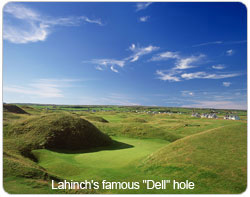 Among the most enjoyable tests in the world of golf is the fifth, the famous "Dell Hole" at Lahinch which even Mackenzie couldn't fathom changing. From the tee, players get a peekaboo view between two tall dunes of a small greensward. Situated a mere 154 yards from the back tees, the blind green can be reached by going over the dune on the left or by bringing in a draw from the right. Just don't be surprised if your tee shot misses this ridiculously tiny putting surface.
Among the most enjoyable tests in the world of golf is the fifth, the famous "Dell Hole" at Lahinch which even Mackenzie couldn't fathom changing. From the tee, players get a peekaboo view between two tall dunes of a small greensward. Situated a mere 154 yards from the back tees, the blind green can be reached by going over the dune on the left or by bringing in a draw from the right. Just don't be surprised if your tee shot misses this ridiculously tiny putting surface.
Perhaps my favorite hole on the back side is No. 15, a lengthy (466-yard) par-4 rated the toughest test on the course. A generous tee-shot landing area suddenly tightens to a mere 10 yards once past a fairway bunker along the left. The second shot may be the most demanding at Lahinch: a long iron or utility club to an elevated green guarded by a bunker to the right.
Slainte
My Irish golf adventure was thrilling. I got to play a lot of golf this time, unlike my previous - and only prior - visit, 15 years ago with my wife and daughter. The friendships and food were great, the nightly Guinness nonpareil, the singing in the pubs spiritually cleansing, and the sense of place Ireland shares with the rest of the world undeniable. Perhaps a couple of Irish toasts are in order. Please visualize the knowing twinkle in an Irishman's eye when you read them:
And:
"Here's to you and yours
And to mine and ours.
And if mine and ours
Ever come across to you and yours,
I hope you and yours will do
As much for mine and ours
As mine and ours have done
For you and yours!"
And:
"Here's to a long life and a merry one.
A quick death and an easy one.
A pretty girl and an honest one.
A cold pint - and another one!"
And:
"May those that love us, love us.
And those that don't love us,
May God turn their hearts.
And if he doesn't turn their hearts,
May he turn their ankles,
So we'll know them by their limping."
And finally:
"May you have the hindsight to know where you've been,
The foresight to know where you are going,
And the insight to know when you have gone too far."
Story Options
 |
Print this Story |
